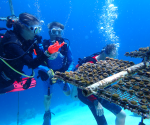Nature Foundation Conducts First Water Quality Assessments in Wetlands and Beaches Post Hurricane Irma. Has Serious Concerns Regarding Water Quality at Kim Sha Beach

PHILIPSBURG — The Nature Foundation carried out water quality tests at seven sites surrounding St. Maarten. These tests, which were conducted for the first time since the passage of Hurricane Irma, were carried out in order to determine the levels of pollutants and other factors affecting wetlands and beaches on St. Maarten.
Tests were carried out in order to determine Nitrates (which shows that the water is polluted), Phosphates and Coliform Bacteria (which shows the presence of Sewage), Nitrogen, Dissolved Oxygen, and the acidity of the water. Tests were carried out on seven sites; Cole Bay Lagoon, Simpson Bay Lagoon, Mullet Pond, Kim Sha Beach, Great Bay Beach, Belair Pond, Fresh Pond, and the Great Salt Pond. The sites of Great Bay Beach and Kim Sha Beach were particularly chosen to test the swimming quality of the beaches.

It was determined that the sites Cole Bay Lagoon, Kim-Sha Beach, Mullet Pond, and Great Bay had medium to high levels of both phosphates and nitrates in samples tested. Elevated levels of nitrates and phosphates show that there is a presence of various types of pollutants and sewage which can cause toxic algal blooms and mortality events (large scale dying of fish, turtle and crabs) in wetlands and coastal areas. The highest level was recorded in the Great Salt Pond and indicates the presence numerous pollutants and sewage in the tested water. Taking this into consideration levels will continuously be monitored by the Nature Foundation.
It was further established that the sites Cole Bay Lagoon, Kim-Sha Beach, Mullet Pond, and Great Bay had low to medium levels of Nitrogen in samples tested. Elevated levels of Nitrogen, caused by pollutants, can cause massive fish die-offs in wetlands and coastal areas. The highest level was recorded in the Great Salt Pond at .6 ppm, which is a relatively high number and indicates the presence of elevated nitrogen levels which can pose a threat to aquatic organisms and which may result in fish die-offs.
Almost all levels of oxygen recorded were at sufficient levels; however the lowest level was recorded in the Great Salt Pond and Belair Pond. These sites should be closely monitored for a further drop in oxygen levels which may result in fish kills and breeding of airborne insects (i.e. Midges).
There is concern that four of the seven sites tested positive for the presence of coliform bacteria, an indicator for the presence of sewage as mentioned. Cole Bay Lagoon, the Great Salt Pond and the Fresh Pond all showed presence levels of coliform bacteria. Particularly worrying is the presence of coliform indicators at Kim Sha beach, which has been designated as a tourism focal point post Hurricane Irma. The Nature Foundation suggests lab level testing to establish the level of coliform bacteria at particularly Kim Sha Beach. Great Bay Beach showed an absence of coliform bacteria indicators.
Despite the fact that many sites showed Medium readings, the Nature Foundation will follow up on a monthly to carefully monitor for changes in the respective levels.

Photo caption: Water quality samples being taken at Great Bay and Kim Sha Beaches; -Sample from Kim Sha beach showing a positive result for Coliform Bacteria.


























